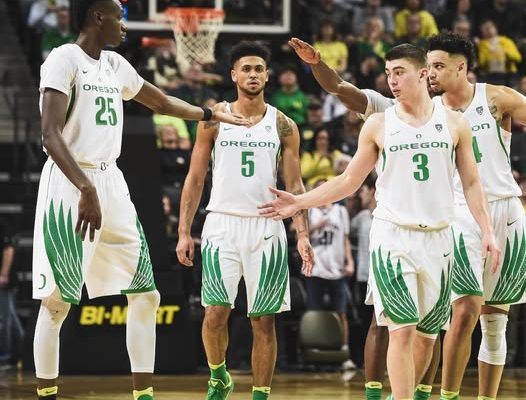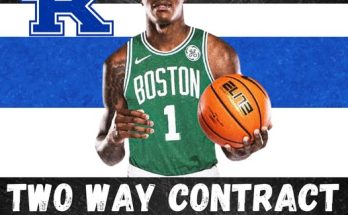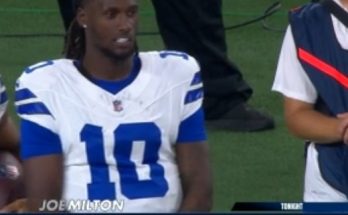“From Ducks to Celtics: A Remarkable Journey of Grit, Growth, and Championship Aspirations Captivates Fans Across the Nation” captures the essence of a story that transcends basketball. It’s a tale rooted in perseverance, dedication, and the relentless pursuit of greatness, tracing a path from collegiate promise to professional aspiration, ultimately landing in the hallowed arenas of the Boston Celtics. For fans and analysts alike, this narrative offers insight into the evolution of an athlete who has navigated challenges, honed skills, and embraced opportunities that have defined both personal and professional growth. While the journey from the Ducks to the Celtics might appear seamless in headlines, the reality behind this transition illuminates the broader dynamics of player development, scouting, and organizational strategy in modern basketball.
The story begins with the early years of collegiate competition, where the athlete in question first donned the uniform of the Ducks. College basketball, particularly at a program recognized for its developmental rigor, offers a unique blend of exposure, high-level competition, and intensive coaching. For this player, time with the Ducks provided not only a platform to showcase raw talent but also an environment to cultivate discipline and resilience. In an era where one-and-done athletes frequently dominate headlines, this journey stood out for its emphasis on incremental growth and consistency over flashiness. Every practice, every game, and every off-season workout contributed to building a foundation that would later prove essential in adapting to the rigors of the NBA.
Statistically, the Ducks tenure was marked by significant milestones. Across multiple seasons, the player demonstrated versatility, capable of impacting games both offensively and defensively. Advanced metrics underscored contributions beyond the traditional box score, highlighting defensive rotations, passing efficiency, and off-ball movement. Analysts noted the player’s ability to read the game, anticipate plays, and make decisions under pressure, traits often considered hallmarks of future professional success. Beyond numbers, leadership qualities emerged, with the athlete serving as a stabilizing force in the locker room and on the court. Coaches consistently emphasized poise, work ethic, and adaptability as key differentiators that set this player apart from peers, establishing credibility that would follow into the next stage of the journey.
Transitioning from collegiate basketball to the professional ranks is rarely straightforward, even for highly touted prospects. The leap from the Ducks to the Celtics involved navigating the intricate mechanics of the NBA draft, scouting evaluations, and strategic fit within a professional system. Scouts were captivated not only by the player’s measurable skills—shooting accuracy, athleticism, and defensive versatility—but also by intangible qualities such as basketball IQ, coachability, and mental toughness. These evaluations revealed an athlete who had matured in college, equipped not just with technical proficiency but with the resilience to withstand the intense scrutiny and expectations of professional basketball. In this context, the journey to Boston was not merely a geographic relocation but a symbolic passage into a league where history, legacy, and competition converge at the highest level.
Boston Celtics fans are acutely aware of the weight of tradition and expectation that accompanies any new acquisition. The franchise’s storied history—spanning decades of championships, legendary players, and iconic moments—creates an environment where performance is evaluated not just in isolation but against a backdrop of excellence. For the player arriving from the Ducks, this meant adapting to a system that values team cohesion, strategic execution, and relentless effort. Initial integration involved intensive conditioning programs, film study sessions, and immersion in the team’s culture. Coaches emphasized understanding defensive schemes, offensive sets, and the nuances of professional preparation. While the transition presented challenges, the athlete’s prior experiences at the Ducks, where adaptability and strategic thinking were nurtured, provided a foundation for quick assimilation and meaningful contribution.
Early performances in the Celtics’ system reflected both potential and learning curves. On the court, flashes of versatility and playmaking ability were evident, signaling alignment with the team’s long-term vision. Offensively, the player demonstrated proficiency in multiple scoring modalities, capable of driving to the basket, hitting perimeter shots, and creating opportunities for teammates. Defensively, the ability to guard multiple positions and anticipate opponent movements made the player an asset in switching schemes and transition defense. Importantly, the adaptation to a professional pace, coupled with the mental resilience developed at the Ducks, allowed for steady growth, earning trust from coaching staff and veteran teammates alike. Analysts quickly highlighted the combination of skill, intelligence, and work ethic as indicators that this athlete could contribute not only immediately but also in the evolution of the franchise’s roster strategy.
Beyond technical performance, the narrative of “From Ducks to Celtics” resonates due to its emphasis on personal growth. The athlete’s journey encapsulates lessons in perseverance, humility, and continuous improvement. In interviews and public appearances, the player consistently credits prior coaches, mentors, and teammates, acknowledging the cumulative impact of every experience on professional readiness. The transition from college to the NBA is often romanticized in media, yet the reality involves rigorous adaptation, learning new systems, managing public attention, and sustaining physical health. This journey illuminates the importance of mental resilience alongside athletic skill, demonstrating how character development plays an integral role in professional achievement. For young athletes observing this trajectory, it serves as a blueprint for embracing challenges, prioritizing development, and maintaining focus amid pressure.
Organizationally, the Celtics’ decision to integrate a player from the Ducks reflects broader trends in team building and scouting. Modern NBA franchises increasingly value multi-faceted skill sets, versatility, and character assessment in addition to pure athleticism. The Celtics’ investment represents a strategic alignment, seeking talent capable of contributing across multiple facets of the game while fitting within an established culture of excellence. This approach underscores the symbiotic relationship between player development and organizational strategy. The athlete benefits from mentorship, structured systems, and championship-oriented culture, while the team gains a player whose potential can be maximized in a context that emphasizes team success over individual accolades. This mutually reinforcing dynamic exemplifies how careful scouting, developmental foresight, and cultural alignment can produce impactful results.
Fans, too, play a critical role in this narrative. From the initial announcement of the acquisition to observing early game performances, the engagement of Celtics supporters amplifies the significance of the journey. Social media reactions, game-day enthusiasm, and community interactions create a feedback loop that validates effort and fosters a sense of belonging within the franchise. The story of moving from Ducks to Celtics, therefore, extends beyond personal achievement; it becomes a collective experience that connects players, organizations, and fans. This communal aspect highlights the societal role of sports, where individual journeys intersect with shared passion, history, and identity. For many, witnessing this progression is a source of inspiration, a testament to dedication, and a reminder of the transformative power of athletic pursuit.
Looking ahead, the trajectory from Ducks to Celtics suggests potential for sustained impact and leadership. With foundational skills firmly established and early professional experience underway, the player is poised to refine offensive versatility, enhance defensive adaptability, and assume roles of increasing responsibility within team structure. Mentorship from veteran players and coaching staff provides additional avenues for growth, fostering both technical mastery and strategic acumen. Importantly, the player’s capacity to navigate transitions, adapt to elevated competition, and maintain composure under scrutiny signals readiness for future challenges, including playoff intensity and championship contention. The ongoing evolution illustrates a broader narrative in professional sports: success is rarely linear, requiring continuous learning, resilience, and alignment with collective goals.
In summation, the story captured by the headline “From Ducks to Celtics: A Remarkable Journey of Grit, Growth, and Championship Aspirations Captivates Fans Across the Nation” is a rich illustration of athletic development, personal resilience, and organizational strategy. Beginning with collegiate experience at the Ducks, where foundational skills, leadership, and adaptability were cultivated, the athlete’s progression into the professional ranks exemplifies the challenges and triumphs inherent in high-level sports. The transition to the Celtics reflects not only individual readiness but also strategic foresight, emphasizing the importance of cultural fit, versatility, and character in modern basketball. As the player continues to evolve, contribute, and inspire, the narrative resonates with fans, analysts, and aspiring athletes alike, offering a blueprint for success grounded in perseverance, continuous improvement, and alignment with collective goals. Ultimately, this journey underscores the timeless values of dedication, resilience, and ambition, highlighting how the path from Ducks to Celtics embodies both professional accomplishment and personal growth in the pursuit of excellence.



